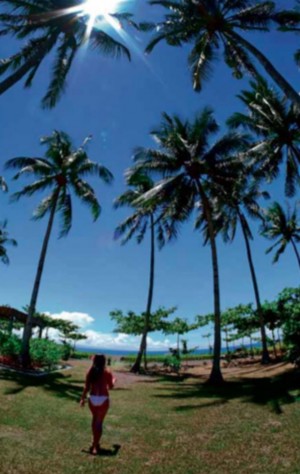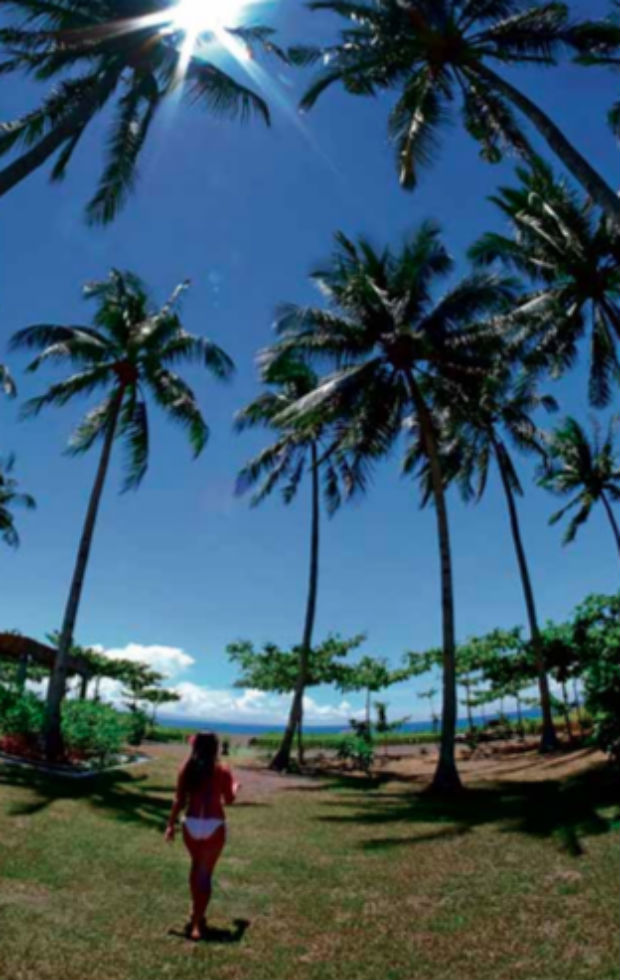
CAMIGUIN, Philippines—With more volcanoes (seven) than towns (five), this island-province in Northern Mindanao has the most number of volcanoes per square kilometer than any other island on earth.
Not surprisingly, Camiguin offers both prime treats and primal threats. Not only waterfalls, hot and cold springs, soda water pools, a powdery white sandbar they call White Island, dramatic dive spots teeming with an astonishing variety of underwater life, and breathtaking mountain trails leading to out-of-the-way lakes, but also doleful volcanic ruins and a sunken cemetery marked by an eerie white cross jutting out of the waves.
The last eruption of Mt. Hibok-Hibok in 1952—when bubbling lava rushed down the mountainside and flooded the lowlands, trapping humans and animals in a river of fire that instantly set them ablaze (the death toll: 600)—prompted the government to set up the agency now known as the Philippine Institute of Volcanology and Seismology (Phivolcs).
Ecotourism package
And we haven’t even mentioned the other volcanoes. Mt. Tres Marias. Mt. Mambajao. Mt. Timpoong. Mt. Uhay. Mt. Ilihan. And Vulcan Daan (Old Vulcan). They are all neatly tied together, as if wrapped in a convenient ecotourism package, by the island’s 64-km coastal circumferential road that you can drive through in half a day. (But why rush when you can simply give in to the many exciting stops along the way?)
“The 1871 eruption of Vulcan Daan ended a way of life,” said academic Nerio Chan.
At the time, the Spanish colonialists administered much of Mindanao from Camiguin. From Cebu, their boats would dock at Catarman, a major center for the Spanish on the island.
“The Spanish authorities wanted to steer clear of the pirates lying in wait along the Mindanao coast. The officials and foot soldiers of the colonial regime disembarked in Camiguin and, with their accompanying baggage, took smaller boats to the Mindanao mainland. That way, their big boats would not be commandeered needlessly,” explained Chan.
Colonial way station
As a colonial way station, Camiguin prospered. Today, you can still see bahay na bato (colonial-era stone house) structures here and there. Nerio himself lives in one such heritage home. His mother, the ever-gracious Laureta (Nang Inday to the community folk), who is pushing 90, is still up and about in the grand family home.
That quintessential island lifestyle was all but ended by the eruption of Vulcan Daan in 1871. On a promontory that plunges into the sea at Bonbon village, you can explore the remains of a circa 16th-century Spanish church, with its cinematic belfry and convento, half-buried in the wake of the eruption. The rest of the prosperous town, including its cemetery, sank into the Bohol Sea. Just like that, the entire port town was gone.
“Here’s a fun fact. When the cemetery sank at Bonbon, our beach rose from the sea,” said Elden Chamberlain with a laugh.
The Englishman and his Filipino husband (they were married in the UK), Cocoy Bajuyo, have just opened a high-end boutique resort, Balai sa Baibai (House by the Beach), in the village of Agoho in Mambajao, the provincial capital.
The 5,000-square-meter lot, with a prime beachfront right across from the popular White Island, does not exist in the old records. “After the Vulcan Daan eruption, this sandy and swampy area just surfaced,” said Chamberlain.
The couple spent two-and-a-half years developing Balai sa Baibai, six months for initial land development, and another two years for construction.
Indigenized world fusion
Elden, an international public health and HIV/AIDS consultant, wanted something open, with lots of fresh air and an unhampered view of the great outdoors.
“I’ve been to over 120 countries, and I wanted Balai sa Baibai to showcase styles from around the globe but firmly grounded in Camiguin and the Philippines. We also tried to source as much construction materials in Camiguin or from within a radius of 100 kilometers from here to minimize our carbon footprint,” he said.
The result may be called an indigenized world fusion of art and architecture.
The capiz windows and okir (wood fretwork) are decidedly Filipino. There’s traditional Thai in the aboveground wooden platforms accented with water and boardwalks leading to the rooms. There’s the signature Balinese thatched roof, but using 30 layers of nipa wrapped in actual fishnets sewn by villagers and topped with Maranao-style carvings that Cocoy did himself.
There’s the salasa, or bamboo-strip lattice work, with a Guatemalan twist: instead of using it as walls, it went up the ceiling. “It took three painstaking months of laying out each strip and nailing it carefully to the ceiling joints without splitting the bamboo,” Cocoy said.
“All the coco and mahogany lumber came from the island. We didn’t want to use a lot of chemicals to treat the lumber, so all the timber and bamboo were soaked in the ocean for weeks,” said Elden.
Market niche
“We only have three rooms at the moment, but this month alone we’re booked for 60, and this is just our second month, you know. So we think our vision is meeting a market niche,” said Cocoy.
By rooms, he means one villa and two suites. (More villas are being built.)
Antiques and artifacts from across the globe decorate every room and space of Balai sa Baibai. From his time living in the north of Australia, Elden has collected quite a few indigenous Australian paintings and carvings, and these make a nice contrast to the Southeast Asian art found throughout the property.
Cocoy pointed to the couple’s most prized possession—an eight-foot solid teakwood carving standing by the solar-filtered swimming pool.
“The intricate all-around carving tells the story of Buddha—from his birth to his journeys to his enlightenment. This carving has been with us in Thailand, the UK and the US, and now it has found its final home here in Camiguin,” he said.
Coming home
In a way, the sculpture mirrors Elden and Cocoy’s journeys that led them to Balai sa Baibai. “It’s been quite an adventure, but now we have found our home,” Cocoy said.
Elden once wrote how he felt when flying back to Camiguin after one of his international consulting projects. “It’s like I’m here again for the first time—the intensity of the colors, the smell of the jungle, and the clarity of the air all tell me that I have come home,” he said.
Balai sa Baibai is certainly showing the tourism industry that travel is not really about going places—it’s about homing in on one’s piece of paradise in this beautiful, frightening world.












































